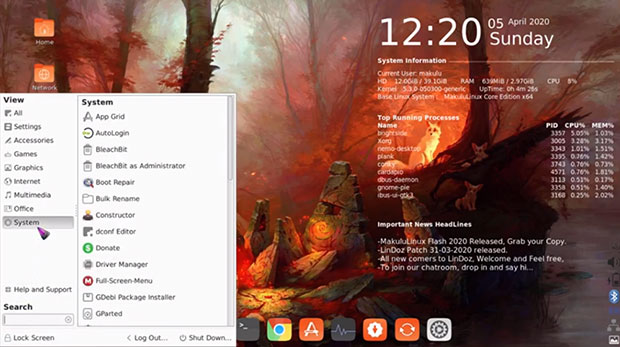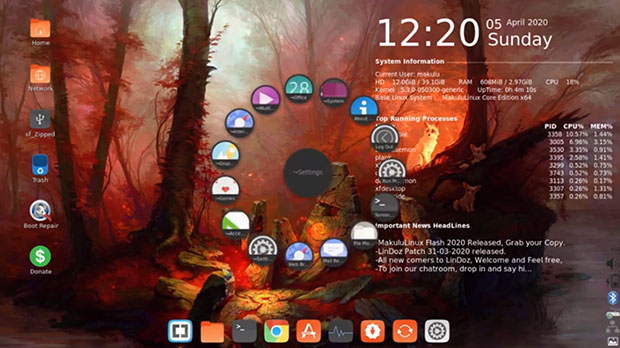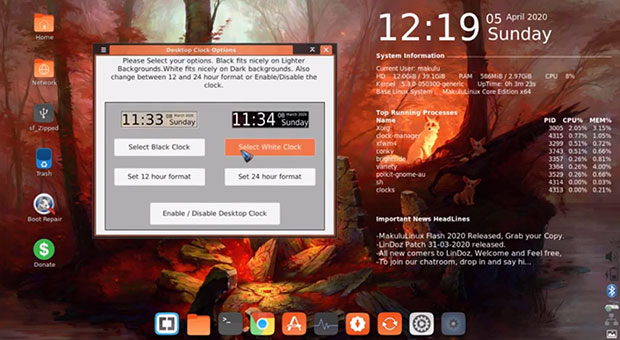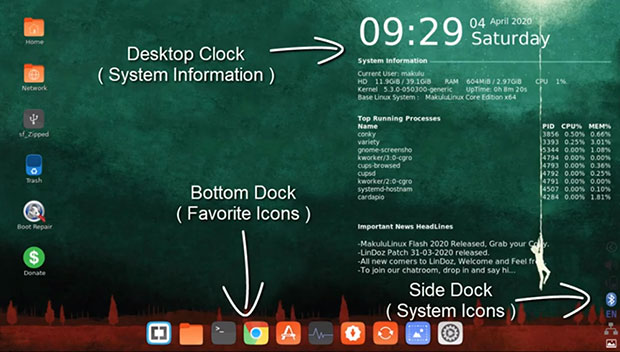If you are looking for a well-designed Linux distro that is far from mainstream, loaded with performance features not found elsewhere, check out the 2020 upgrade of the MakuluLinux Core distro. It could change your perspective on what a daily computing driver should offer.
Developer Jacque Montague Raymer recently released the 2020 edition of MakuluLinux Core OS. This latest release follows the previous major upgrade by 15 months. It integrates some of the features of its two cousins and improves its homegrown user interface, which includes a unique circular main menu display. The result is a higher level of usability that turns Core into a modern Linux platform.
MakuluLinux comes in three editions: LinDoz, featuring an in-house modification of the Cinnamon desktop; Flash, running an in-house modified version of the Xfce environment; and Core, presenting a highly customized desktop forked from Xfce and Cinnamon with elements of GNOME.
Core introduces some radical changes. Raymer released the 2020 upgrade editions for LinDoz and Flash over the last two months.
MakuluLinux is a partial rolling release operating system that debuted in 2013 with a different approach to implementing Linux OS features. The last few years have brought considerable change and new development to this Linux family.
Now based in Vietnam, the developer first debuted the infant distro from his previous location. Hence the distro’s name reflects the African continent. “Makulu” is the word for “big chief” in the Zulu language. Spend a little time with MakuluLinux 2020 family releases to discover how very appropriate the name is in branding this Linux distro.
Earlier versions offered a choice of Xfce, KDE and Enlightenment 17 desktops. Rebuilt from the ground up in 2015, all three editions include preinstalled multimedia codecs, device drivers, and software for everyday use. All three 2020 editions are built on the new 2020 Series Base designed to enhance the three MakuluLinux flavors and extend long-term support.
Raymer built the previous code base on the Debian Testing Branch, but he took a different approach with this new base, designing it to get under-the-hood updates from the Ubuntu Bionic repository. This gives the 2020 releases a life cycle until 2023, which can be extended to 2028.
The MakuluLinux project has traveled a long road to reach its current destination. The latest arrival sports a new gorgeous graphical user interface (GUI) tweaked in all three editions.
Mega Menu Mania
Core’s interface comes with three menus built into the design. The menu system is perhaps one of the more alluring features in the Core release.
The main menu button on the far end of the bottom dock automatically opens a unique in-house developed spin-wheel style circular menu display. This circular or ring menu displays in the center of the screen. Core has configurable hot corners that give you additional access to menus.
The default action when you press the mouse pointer into the upper left corner is full-screen menu. You can change any of the menu and other default settings from within the system settings panel.
Or put the mouse pointer into the left bottom corner to get a traditional two-column vertical menu to appear along the bottom left edge of the screen. Another option is pressing the dedicated Windows key to pop up the same Whisker-style menu in the center of the screen.

You can right-click anywhere on the desktop to access the “main menu” of choice. You can choose to make the ring, the traditional, or the full screen menu open by default.
The ring-style menu is certainly different. The one drawback to using it, however, is difficulty finding what you want if you’re not fully used to the installed software.
You still have to click on a circular category display to open other rings to see a list of applications. A search field would go a long way to eliminating the endless searching.
Alluring Appearance
Core looks very modern and has lots of catchy colors and artwork built into its design. MakuluLinux Core is designed to be traditional while also catering to the next generation of Linux users.
Besides the tri-menu system, Core uses dual docks and is a mouse-driven gesture operating system. A large display shows essential system information in the upper right quadrant of the screen.
A Cairo-type dock for favorite applications replaces the traditional bottom panel. A small system notification dock sits vertically along the lower right edge of the screen. Key application launchers line up vertically along the left screen edge. This design keeps the essential system elements separate from the applications dock.
Both long-time Linux users and newcomers to Linux should find Core’s design intriguing and simple to navigate around the desktop. The optional gesture system bypasses the need to touch the keyboard for those users so inclined.
Core also offers many instant-access features that add to the operating system’s fun interface. These include a one-click wallpaper changer, one-click 3D option, and the ability to control every aspect of Core’s performance with a few clicks.
Distinctly Different
The biggest difference that distinguishes the Core OS from MakuluLinux’s alternative LinDoz and Flash platforms is the way the Xfce desktop design works as the unique Core desktop. Core borrows heavily from the Xfce tweaking in Flash.
In numerous ways, Core’s desktop design blends some of the best features found in Flash’s use of Xfce and the forked Cinnamon environment that LinDoz uses. Still, all three editions remain unique operating systems in their own right.
With the Core edition, you can enable an option for auto-starting the screen-share application at boot-up. Or you can start the service manually when needed.
One of the little things that makes the three MakuluLinux distros artistically distinct is the wallpaper. The background images are stunning.
Core, Flash and LinDoz use the same Wallpaper Changer tool, but each has a unique set of scenery to display. Core’s wallpaper display scrolls across the top of the screen.
If you are a power user, you can fine-tune Core to your heart’s delight. If you are not into fiddling with settings, Core’s default configurations work fine.
Features Galore
One of Core’s more radical interface innovations is the new circular menu display. Application icons and launchers for system tools appear in a spin-wheel design displaying icons for each software category.

Fly over any icon in the circular array to have the contents of that category hang in a larger circle layered over the main menu display in the center of the screen. The menu system is also hot corner-based.
You trigger the new menu along with a few custom actions by mousing into the designated screen corners. Use the Hot Corner option in System Settings to set up your choices.
Core runs on the Linux 5.3xx kernel and has 3D support from built-in Compiz and the Emerald System. The mouse-driven gesture system with touchscreen support bring added capabilities to this distro.
Other goodies include 23 beautiful theme variations with icon sets and mouse cursors to match. It comes with huge driver support out of the box.
Navigating Workspaces an Issue
I found the changes to Core’s handling of virtual desktops to be a side step if not a full step backward. Core has no panel applets. That means you have no access to a convenient workplace switcher applet.
I am somewhat anal when it comes to using virtual desktops or workspaces. My workflow demands multitasking: researching, note-taking, writing, editing and creating graphics.
If moving among workspace screens is not fast, fluid and intuitive, I do not hesitate to flag a Linux distro. The key to success for me usually is anchored in keyboard shortcuts and workspace switcher applets on a bottom panel.
In this latest Core release, I found neither. It does have the right-click desktop menu option built into window top borders — but Core has no panel applets.
In the last Core release, I could point the mouse pointer on the desktop and press and hold the button wheel or the middle button. Other options included pressing the CTRL + left/right arrow keys, or pressing the left and right touchpad buttons.
None of those navigation options are built into this latest Core edition. Nor are the Scale and Expo views available. Taken together, these missing features make using virtual workspaces a losing proposition.
A Graphical Glitch
Another issue exists with the right dock panel, which is an Xfce-based panel that houses all the system notifications. Opening the settings of the right dock shows a settings icon on the bottom dock. No problem there.
However, when you close the settings, the icon sometimes remains in the bottom dock. This is just a graphical glitch, according to Raymer.
It can be removed when you re-log or reboot your system. Other than being an annoyance or inconvenience, it cannot harm your system.
Bottom Line
Through the years MakuluLinux developer Raymer has tried to make his distribution easy to use. He wanted to maintain simplicity with complexity and beauty at its Core. That involved combining a unique balance of stability, raw power, extreme speed, pure beauty and absolute ease of use, he said.
The MakuluLinux 2020 releases solidly hit those marks. While a matter of personal preference, the Core edition surpasses the accomplishments of LinDoz and Flash.
Core’s minimum Ram requirements are 1 GB or more. It should be installed with at least 15 GB storage space available.
Check out the Easter Eggs hidden within. Right-click on the desktop menu. It is packed full of goodies.
Suggest a Review
Is there a Linux software application or distro you’d like to suggest for review? Something you love or would like to get to know?
Email your ideas to me, and I’ll consider them for a future column.
And use the Reader Comments feature below to provide your input!
























































